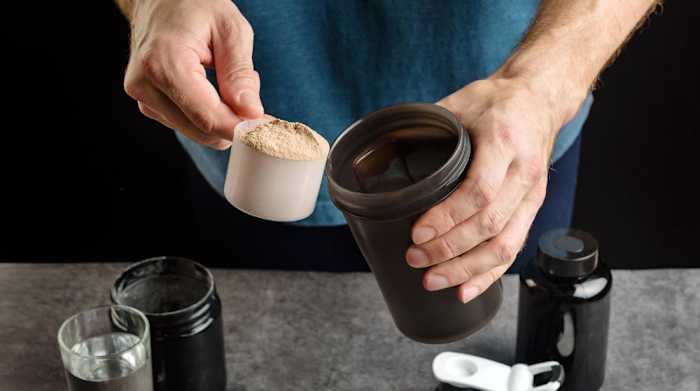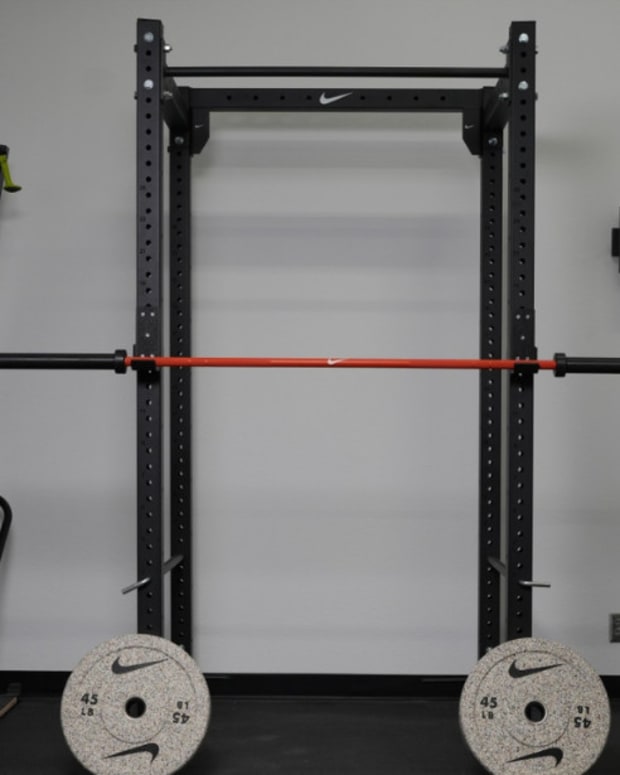The products featured in this article have been independently reviewed. When you buy something through the retail links on this page, we may earn commission at no cost to you, the reader. Sports Illustrated editorial staff are not involved in the creation of this content. Learn more here.
Protein is found in a variety of food sources, but it’s often difficult to consume enough through food alone. That’s why protein powder is one of the most popular dietary supplements for individuals looking to increase their dietary protein intake. Whether you’re an athlete or bodybuilder, have weight loss goals or are simply looking to build some lean muscle mass, a protein powder offers a convenient and efficient way to supplement your diet with more of this muscle building macronutrient.
Once you’ve found the best protein powder for your goals, it can be challenging to know how much to consume, when to consume it and the optimal way to integrate protein powder into your health routine. In this comprehensive guide, we’ll examine the benefits of using a protein powder, touch on the different types available, help you calculate how much protein you need each day and offer our favorite ways to use protein powder.
Benefits of Protein Powder
Muscle growth and repair
Protein is an essential macronutrient that plays a key role in muscle growth and repair. When you engage in physical activity, such as weightlifting or resistance training, your muscles sustain tiny tears and damage. To repair these muscles, the body breaks down the protein you consume into amino acids, which are then used by the body to build new muscle tissue.
Recovery
When you consume protein powder after a workout, it provides the amino acids necessary to promote muscle protein synthesis, which is the process of building new muscle tissue. Protein also helps to reduce muscle inflammation and soreness by providing the nutrients necessary to support muscle recovery. Consuming an adequate amount of protein helps speed up the recovery time necessary before a subsequent training session.
Weight loss
Consuming an adequate amount of protein can be a helpful weight loss tool for a few different reasons. The first is that protein is known for promoting feelings of fullness, which may help reduce the total number of calories you consume throughout the day. Protein also has the highest thermic effect of food, which means that your body burns more calories digesting and processing protein than carbohydrates or fats. Finally, protein is helpful for maintaining muscle mass when in a weight loss phase. Eating enough protein can help minimize muscle loss and prioritize the burning of excess body fat for energy.
Related Post: The Best Protein Powders to Keep You Fueled During Your 2024 Weight Loss Journey
Convenience
Protein powder is an easy, convenient way to supplement your diet with additional protein. Protein powder is also incredibly versatile, and comes in a variety of different forms including whey, casein and plant-based options like soy protein or pea protein, which makes it easy to incorporate into a variety of different lifestyles and diets.
Types of Protein Powder
There are a few different types of protein powder available, and each has its own unique characteristics and benefits.
Whey protein
Whey protein is the most commonly used form of protein powder, and an animal-based supplement derived from milk. It’s easily digested by most individuals and contains all of the essential amino acids our bodies need to repair and build muscle. Whey protein comes in a few different forms, including whey protein concentrate, isolate and hydrolysate, which differ slightly in terms of digestibility, number of calories and macronutrient profile.
Casein protein
Casein, similar to whey, is another animal-based protein powder derived from milk. It’s digested more slowly than whey protein, and is most commonly used as a meal replacement shake or high protein snack before bed to help prevent muscle breakdown while you sleep.
Related Post: Meal Replacements vs Protein Shakes: Why The Differences Matter
Plant-based protein
Plant-based protein powders are derived from plant protein sources like soy, peas, rice and seeds (chia, flax, hemp, etc.). Most plant-based protein powders contain a blend of these different plant-based protein sources in order to ensure a complete amino acid profile. These protein powders are a great option for individuals who are lactose intolerant or follow a vegan or vegetarian diet.
Related Post: Pea Protein vs Whey: Which One is Right for You?
How Much Protein Do I Need a Day?
The amount of protein you should consume each day varies from person to person, and primarily depends on your daily physical activity level. The recommended daily allowance for protein consumption is set at 0.8 grams per kilogram of body weight. This recommendation reflects the minimum amount of dietary protein required to prevent muscle loss. That being said, organizations such as the International Society for Sports Nutrition suggest that physically active individuals should have a protein intake somewhere between 1.4 and 2.0 grams per kilogram of bodyweight to promote muscle repair and growth.
How to Use Protein Powder for Weight Loss
Protein powder can be an effective weight loss tool because most protein powders have a high protein-to-calorie ratio. This means that the majority of calories in a protein powder are coming from protein alone. If your weight loss strategy involves calorie counting, then a protein powder is a good option to help you round out your protein goals for the day without excess calories from carbohydrates and fats.
Protein is also an extremely important macronutrient when following a weight loss protocol, as it can help you maintain muscle mass while you’re losing weight. Consuming an adequate amount of protein will help ensure the weight you are losing is from excess body fat rather than lean muscle tissue. In addition to achieving a better body composition through lean muscle preservation and fat loss, muscle tissue is also more metabolically active than fat. This means that having more muscle mass increases the amount of calories you burn on a daily basis. Adding a protein powder to your routine can help you meet your dietary protein intake for the day, which helps preserve as much muscle mass as possible during a caloric deficit.
How to Use Protein Powder for Muscle Gain
Adding a protein powder into your supplement regimen can be an effective way to build muscle when also paired with a resistance training program. Studies suggest that consuming 20 to 25 grams of a high-quality protein, which is typically the amount of protein found in a serving size of protein powder, will maximize the body's muscle protein synthesis response. If you have muscle building goals, then a good strategy is to take your total daily protein intake and spread it evenly among your meals. A protein powder can be a great way to help you meet this daily protein requirement.
Related Post: The 11 Best Protein Powders for Muscle Gain
Different Ways to Use Protein Powder
There are countless ways to use a protein powder outside of the classic protein shake. And while you can find protein powder in other food forms, like protein bars, cookies and chips, we’ve rounded up a few of our favorite smoothies, snacks and meals that incorporate protein powder into their recipes.
Strawberry Coconut Goodness Smoothie by Gainful
This recipe includes strawberries (fresh or frozen), coconut milk, vanilla protein powder, honey, vanilla extract and ground flax seed.
Related: Gainful Protein Powder: A Certified Nutrition Coach’s Review (2024 Update)
Chocolate Banana Peanut Butter Shake by Gainful
This recipe includes ice cubes, milk, banana, chocolate protein powder, peanut butter, honey and unsweetened cocoa powder.
Pink Porridge by KOS
This recipe makes one serving, takes a few minutes to prep and has a cook time of less than two minutes. The benefit of this recipe is that it's gluten-free, nut-free, sugar-free, vegan and vegetarian. The ingredients include a half cup of quick oats, one scoop of KOS Love You Berry Much Reds Blend Powder, a half cup of hot water, a third cup of plant milk, a half teaspoon of chia seeds and toppings like shredded coconut, sliced banana and more chia seeds.
Creamy Protein Pasta by KOS
This recipe from KOS for creamy protein pasta uses protein powder in a novel way to add some protein to a classic pasta dish. This recipe has a five-minute prep time, 15-minute cook time and is both vegan and vegetarian friendly. The ingredients list includes one scoop of KOS vanilla protein, one package of pasta, two tablespoons of vegan butter, four cloves of garlic that have been diced, four to eight ounces of white wine (depending on your taste preferences), 12 ounces of unsweetened non-dairy milk, one teaspoon of “no-chicken” or vegetable bouillon base, a quarter cup of vegan parmesan cheese, two tablespoons of flour and salt and pepper to taste.
Aushra’s Protein Pancakes by Kaged
This delicious breakfast recipe has 37 grams of protein, 34 grams of carbs and four grams of fat per serving. The recipe says that the prep and cook time combined will be around 15 minutes and will make approximately four pancakes. The ingredients list includes one scoop of vanilla whey protein isolate, a quarter cup of liquid egg whites, a half cup of raw oats, a pinch of salt, one packet of stevia or Splenda, butter spray and sugar-free syrup.
Sweet Potato Protein Brownies by Kaged
These sweet potato protein brownies are a filling take on a classic sweet treat. It’s a recipe I’ve tried myself, and it tastes fantastic. The ingredients include three large sweet potatoes, two to three scoops of casein protein powder (based on the macronutrient profile you’re looking for), one teaspoon of baking powder, a third cup of organic coconut oil, three egg whites, two whole eggs, four tablespoons of raw cacao powder and two tablespoons of flaxseeds.
Using Protein Powder FAQs
Can you add protein powder to anything?
I wouldn’t say that you could add protein powder to anything, but there are a ton of different ways to use a protein powder besides mixing it with water in a shaker bottle. The most common way to use a protein powder, aside from the standard protein shake, is in a protein smoothie that typically includes fruit, seeds, Greek yogurt and possibly even spinach. Protein powder is also a great addition to oatmeal, cereal and baked goods like muffins and pancakes, and it’s usually a staple in homemade protein balls and bars.
Can I take protein powder without working out?
Yes, you can definitely use a protein powder without working out. However, if you don’t work out, then you likely have a lower protein demand than those who do. This means that you may be able to consume an adequate amount of protein through your diet alone and not require the use of a protein powder supplement.
When should I avoid protein powder?
While protein powder can be a convenient way to supplement your protein intake, there may be certain situations where you would want to avoid it. The first is if you have any allergies or intolerances to protein supplements. That being said, there are so many different protein powders available, including both animal-based and plant-based protein sources, that you can usually find a protein powder that suits your needs.
You may also want to avoid the use of a protein powder if you have any pre-existing conditions, such as kidney problems. If you have any kidney issues, a high protein diet may not be recommended, and you should consult with your primary healthcare provider before adding a protein powder to your diet.
Another situation where you’d want to avoid or limit the use of protein powder is if you’re using it instead of whole foods. Whole food sources of protein like meat, dairy, eggs and tofu contain a variety of additional nutrients that are beneficial for the body and not found in protein powders.
What happens if I eat a high protein diet but don’t work out?
Whether or not you work out, there isn’t any evidence that a high protein diet will cause any detrimental effects in healthy individuals. As long as you’re consuming a healthy, balanced diet and not severely overeating or undereating calories, then a high protein diet should be completely safe.
Should you have a protein shake before or after a workout?
Consuming a protein shake either pre- or post-workout will generate similar health benefits, and it really comes down to your personal preferences, goals and schedule to determine which option will be the best for you. Protein consumption before a training session has been shown to help prevent muscle breakdown during exercise and provide some additional energy for your workout, while protein after a training session can help to repair and rebuild muscle tissue that was damaged during training.
Both of these are great options; however, unless you’re competing at the highest level and training multiple times per day, when you choose to consume your protein won’t make much of a difference. It’s far more valuable to consistently hit your total daily protein goals than worry about exactly when you’re consuming your protein each day.
Takeaway
Protein powder can be an excellent addition to a healthy diet and exercise routine for individuals looking to pack on some lean muscle mass. While it shouldn’t be your main source of dietary protein, it can help supplement your diet to ensure you’re consistently meeting your daily protein goals. Hopefully this article has shown you that you can do far more with protein powder than simply mixing it into a traditional protein shake. It can be a great addition to a variety of different recipes for a bit of added protein—you just need to be creative.









